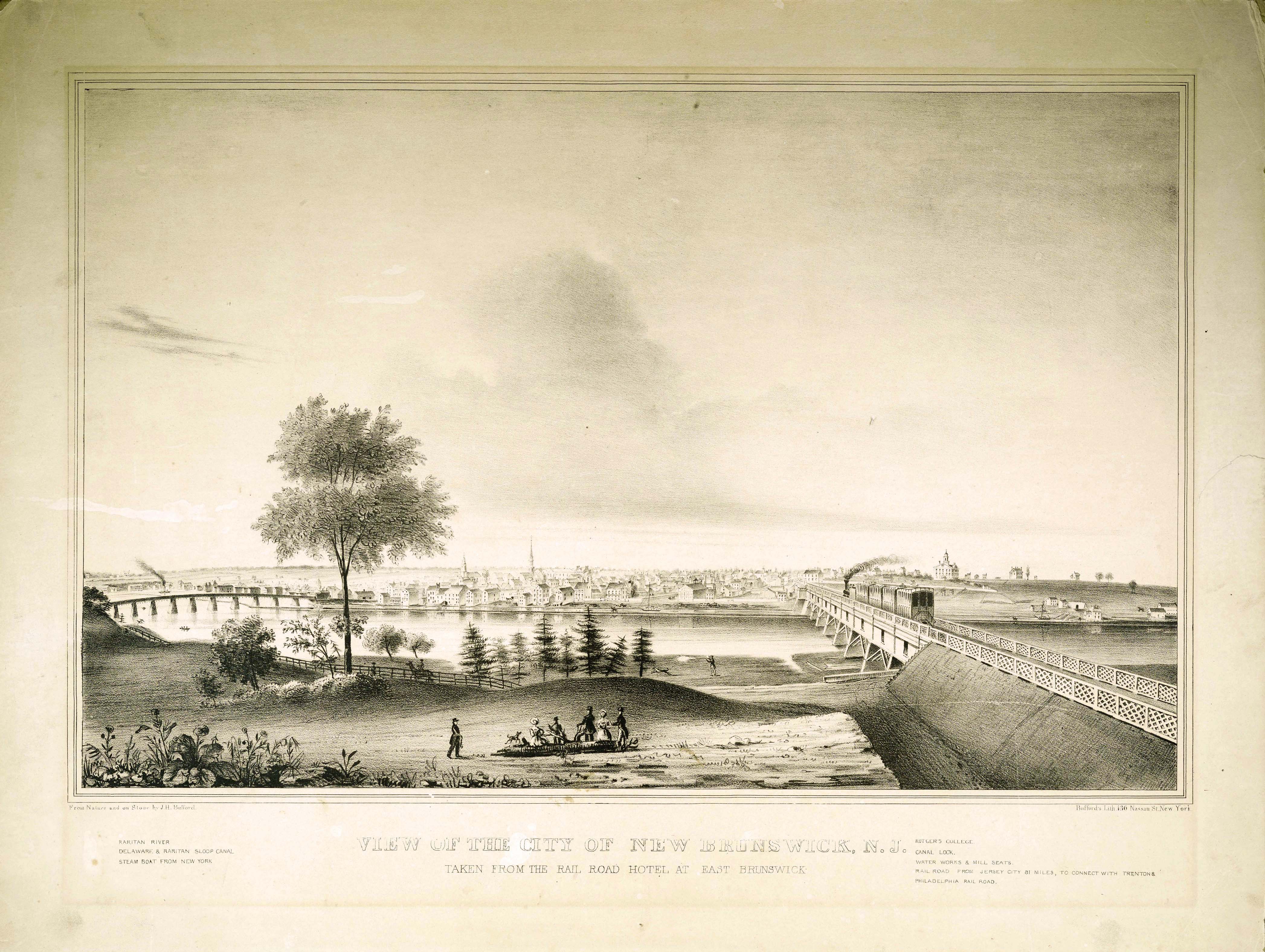Alvarez, Ann. The Mass Grave at the First Reformed Church. New Brunswick, NJ. East Brunswick Historical Society, 2008.
American Whig Society. Catalogue of the American Whig Society. Princeton, NJ: Published by the order of the Society, Princeton University, 1865.
Bowman, Bill. Murderer of the Year: A True Story. PJB Creatives, Inc., 2009.
Boyd, William Henry. Boyd’s Newark Business Directory. Newark, NJ: A.J. Dennis & Co., 1857
Brown, Mercy. Loud is How I Love You: A Hub City Romance. New York: InterMix Books, 2016.
Clark, Rhonda L. and Miller, Nicole Wedemeyer. Fostering Family History Services: A Guide for Librarians, Archivists, and Volunteers. Santa Barbara, CA: Libraries Unlimited, 2016.
Cohen, Ronny. From Homer to Hopper: American Visions in 19th and 20th Century Art. Selections from the Permanent Collection of the Canajoharie Library and Art Gallery. Princeton, NJ: Bristol-Myers Squibb, Co., 1990 .
Degrassi, Carol. City of Somers Point: Before and After (Vol. 1). Somers Point, NJ: Somers Point Historical Society, 2004.
Directory of the City of Trenton 1854/1855. Trenton, N.J. : J.M. Clark, R.H. Moore, J.O. Raum, 1855.
Forgosh, Linda B. Louis Bamberger: Department Store Innovator and Philanthropist. Waltham, MA: Brandeis University Press, 2016.
Friends of New Netherland and New Brunswick Theological Seminary. Reflections on the World: The Writings of Howard G. Hageman. Albany: New Netherland Publishing, 1993.
Fuentes, Marissa J. and White, Deborah Gray. Scarlet and Black Volume 1: Slavery and Dispossession in Rutgers History. New Brunswick, NJ: Rutgers University Press, 2016.
Green, Howard L. and Associates, Inc. Telephone Survey of Food Store Shopping Habits, Opinions, and Attitudes in Kings Marketing Area. Troy, MI. May 5,1989.
Green, Howard L. and Associates, Inc. In-Store Survey Results for Nine Kings Super Markets. Troy, MI. January 26, 1990.
Green Book Street Directory of Trenton and Adjacent Territory, Historic Places of Interest and General Information. Trenton, NJ: L.B. Prince, 1932.
Hajdu, David. Love for Sale: Pop Music in America. New York: Farrar, Strauss and Giroux, 2016.
Havens, Mark. Out of Season: The Vanishing Architecture of the Wildwoods. London: Booth-Clibborn Editions, 2016.
Havens, Jessie L. Cold Case: Hall-Mills Murderer Revisited. Bridgewater, NJ: Heritage Trail Association, 2016.
Jardim, Edward A. The Ironbound: An Illustrated History of Newark’s “Down Neck.” Frenchtown, NJ: Stone Creek Publications, 2016.
Karcher, Joseph T. A Municipal History of the Township of Sayreville, 1876-1920. Boston: Meader Publishing Company, 1953.
Kem-Lec-Mek: The Annual of the Students, College of Engineering. Newark, NJ: Newark Technical School, 1926.
Ketler, William H. Chronic Kicker on Politics. Camden, NJ: Outlook Company, 1900.
Listokin, David, Dorothea Berkhout and James W. Hughes. New Brunswick, New Jersey: The Decline and Revitalization of Urban America. New Brunswick, NJ: Rutgers University Press, 2016.
Lloyd, Carli and Coffey, Wayne. When Nobody was Watching My Hard-Fought Journey to the Top of the Soccer World. New York: Houghton Mifflin Harcourt, 2016.
Lurie, Maxine N. and Richard Veit. Envisioning New Jersey: An Illustrated History of the Garden State. New Brunswick, NJ: Rutgers University Press, 2016.
Masur, Louis P. Runaway Dream: Born to Run and Bruce Springsteen’s American Vision. New York: Bloomsbury Press, 2009.
McCarthy. George M. The Evolution of a Sentiment. Jersey City, NJ: G.M. McCarthy, 1905.
Monmouth County Planning Board. Study of Population: Monmouth County. Court Street and Lafayette Place, Freehold, NJ, April, 1974.
Monmouth County Planning Board. Economic Base Abstract for Monmouth County. March, 1976.
Monmouth County Planning Board. Monmouth County Planning Area 6: Land Use. Freehold, NJ. July,1976
Monmouth County Planning Board. Monmouth County Planning area 4: Land Use. Freehold, NJ. August,1977.
Monmouth University. 19th Century Maritime Art: Our History in Paintings. Pollak Gallery, October 13- 23, 2011. West Long Branch, NJ: Monmouth University, 2011.
Moss, Sandra W. Poliomyelitis: Newark 1916, “The Grip of Terror.” Xlibris, 2016.
Myers, Gordon. Yankee Doodle Fought Here: Being an Historic Musical-Narrative Featuring the Songs and Words of People who Lived in 18th Century America. Newfield, NJ: D.P.R. Publishers, 1975.
National Jewish Committee on Scouting. The Ner Tamid Guide for Boy Scouts and Explorers. New Brunswick, NJ, 1961.
Negron, Rosina. Comparison and General Analysis of Support Systems for Heritage Sites in New Jersey, California and Puerto Rico. Philadelphia: Managing Heritage for Sustainability, Graduate School of Fine Arts, University of Pennsylvania, 1999.
New Jersey National Guard, Cavalry Regiment, 102nd. First Squadron of Cavalry NJ: Essex Troop: 100th Anniversary of the Mexican Border Campaign, 1916-1917. West Orange, NJ: 102nd Cavalry Regiment Association, 2016.
New Jersey State Highway Department, Bureau of Public Information. Development of the State Highway System: New Jersey. Trenton, NJ: 1960.
New York Shipbuilding Corporation. Safety Rules and Regulations. Camden, NJ: New York Shipbuilding Corporation, 1941.
Nutt, Charles W. Life Happens: How Catholic Baby Boomers Coped with a Changing World. Vineland, NJ: Anlo Communications, L.L.C., 2009.
Passaic County Tuberculosis and Health Association. Annual Report. Paterson, NJ: Passaic County Tuberculosis and Health Association, 1947.
Rabig, Julia. The Fixers: Devolution, Development & Civil Society in Newark, 1960-1990. Chicago: The University of Chicago Press, 2016.
Rosenfelt, David. Blackout. New York: St. Martin’s Paperbacks, 2016.
Shea, Hunter. The Jersey Devil. New York: Pinnacle Books, 2016.
Somerset County Planning Board. Draft: Somerset County Planning Board Housing Trends Assessment Report. Somerville, NJ: 2016.
Stewart, Kelly Loyd. An Illustrated History of the Society of The Cincinnati in The State of New Jersey. The Society of the Cincinnati in The State of New Jersey, 2014
Sullivan, Jaime Primak and Eve Adamson. The Southern Education of a Jersey Girl: Adventures in life and Love in the Heart of Dixie. New York: Touchstone, 2016.
Trenton, New Jersey Department of Housing and Development. Preservation Guidelines. Trenton, NJ: City of Trenton, Department of Housing and Development, 1979.
Ventresca, Yvonne. Black Flowers, White Lies. New York: Skyhorse Publishing, 2016.
Wacker, Peter O. Etching The Rural Landscape in Early New Jersey. 2000.
Webster, Noah. An American Dictionary of the English Language. New York: White and Sheffield, 1842.
Woodbury, David O. A Measure for Greatness: A Short Biography of Edward Weston. New York: McGraw-Hill, 1949.
Zampini, Daniel James. After it Rains. Haverhill, MA: Fireborn Publishing, 2016














 By Flora Boros
By Flora Boros


























